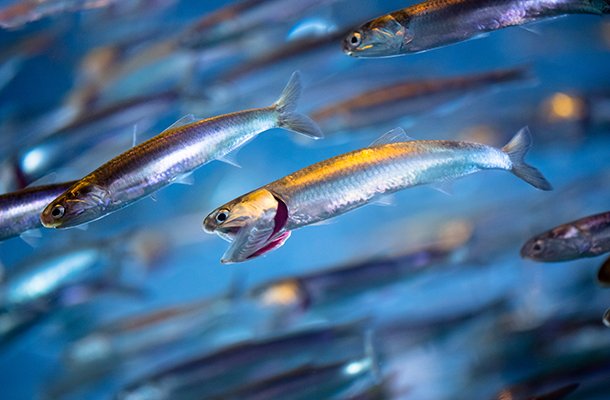
Understanding how anchovies breed can help us appreciate their role in the ecosystem. Let’s dive into their world and explore the steps involved in anchovy reproduction, from their spawning habits to the challenges they face. We’ll introduce you to these remarkable fish, giving you a peek behind the curtain of their underwater life.
What Are Anchovies?
Anchovies are small, schooling fish that belong to the Engraulidae family. These fish are found in oceans all over the world, often near coastal waters. You might be wondering what makes them so special. For many, they are a culinary delight, but they also play an essential role in marine ecosystems. As prey for various ocean predators, anchovies contribute to a balanced food web.
The most common species is the *Engraulis encrasicolus*, often found in the temperate waters of the Atlantic. Anchovies thrive in large schools, which not only increases their chances of reproduction but also helps protect them from predators. Imagine a tight-knit community where everyone looks out for each other—that’s what anchovy schools embody.
The Life Cycle of Anchovies
The life cycle of an anchovy is a remarkable journey that unfolds in several stages. First off, anchovies go through the typical phases of life: egg, larva, juvenile, and adult. Let’s break these down to see how they grow and reproduce.
1. Egg Stage: Anchovies are surface spawners, meaning they lay their eggs in the upper layers of the ocean. A female can produce thousands of eggs at once, often when the water temperature rises. These eggs are tiny, and they typically float on the surface until they hatch.
2. Larval Stage: After about one to two weeks, the eggs hatch into larvae. This is a critical stage, as they are very vulnerable to predation. Larvae feed on microscopic organisms, helping them grow quickly.
3. Juvenile Stage: As they mature, anchovy larvae develop into juveniles. During this time, they grow more robust and start to form schools. This schooling behavior is crucial for protection against predators.
4. Adult Stage: Once they reach maturity, which usually takes about 6 months to a year, anchovies are ready to breed and continue the life cycle.
Spawning Habits of Anchovies
Spawning is the term used for breeding in fish, and for anchovies, it involves some exciting behaviors. Anchovies typically spawn during warmer months when water temperatures hover around 15 to 20 degrees Celsius (59 to 68 degrees Fahrenheit).
They usually spawn at night, which provides a layer of protection from predators. During this time, females release eggs while males simultaneously release sperm into the water. It’s a synchronized spectacle that occurs in large schools and ensures maximum fertilization of the eggs. Here’s the thing: the number of eggs laid can be staggering, with one female potentially shedding over 100,000 eggs in a single spawning event!
Environmental Factors Affecting Reproduction
Several environmental factors play a crucial role in the breeding and reproduction of anchovies. Temperature and availability of food are two significant elements influencing their spawning success.
1. Water Temperature: Warmer waters are better for spawning. If the water is too cold, it can delay or even prevent breeding, impacting the overall anchovy population.
2. Food Availability: Anchovies primarily feed on plankton. If there’s a good supply of food, anchovies can grow and reproduce healthily. A lack of food can lead to stress and impact their reproductive capabilities.
3. Salinity Levels: Anchovies prefer coastal environments where salinity levels are optimal for their life processes. If salinity changes too much, it can disrupt their spawning habits.
The health of anchovy populations is closely tied to these factors. When changes occur, such as pollution or climate change, it can throw their breeding patterns off balance.
Challenges in Breeding and Reproduction
Despite their resilient nature, anchovies face numerous challenges in breeding and reproduction.
– Overfishing: One of the most significant threats to anchovy populations is overfishing. As humans fish these species excessively, it not only reduces their numbers but also disrupts their spawning cycles.
– Pollution: Water quality is vital for reproductive success. Pollutants can lead to decreased egg viability and increased mortality rates among larvae.
– Climate Change: Changes in ocean temperatures and currents can affect food availability and spawning grounds. Anchovies may struggle to adapt to these rapid changes, leading to potential declines in their populations.
The Importance of Anchovy in Ecosystems
Anchovies are more than just a tasty ingredient; they are crucial players in marine food webs. They serve as primary food sources for various larger fish, seabirds, and marine mammals. Their breeding and reproduction contribute to the overall health of marine environments.
When anchovy populations are healthy, they help maintain balance in the ecosystem. With their rapid growth and reproductive capability, a single anchovy school can significantly impact the food chain. Keeping their populations strong is essential for preserving not just anchovies but also the species that depend on them for survival.
Understanding the breeding and reproduction of anchovies is vital for anyone interested in marine biology or ecology. These small fish play a big role in our oceans’ health and our culinary experiences. As we continue to enjoy anchovies on our plates, it’s essential to advocate for sustainable fishing practices and protect their habitats.
By recognizing the challenges they face and promoting conservation efforts, we can help ensure that anchovies continue to thrive in the wild and support the balance of marine ecosystems for future generations. Remember, every little fish counts, and anchovies are no exception!
